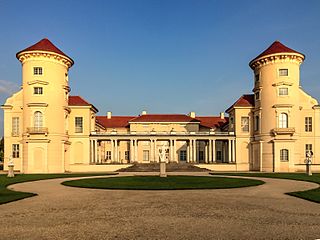
Sophia Charlotte of Hanover was the first Queen consort in Prussia as wife of King Frederick I. She was the only daughter of Elector Ernest Augustus of Hanover and his wife Sophia of the Palatinate. Her eldest brother, George Louis, succeeded to the British throne in 1714 as King George I.

Anton Graff was an eminent Swiss portrait artist. Among his famous subjects were Friedrich Schiller, Christoph Willibald Gluck, Heinrich von Kleist, Frederick the Great, Friederike Sophie Seyler, Johann Gottfried Herder, Gotthold Ephraim Lessing, Moses Mendelssohn and Christian Felix Weiße. His pupils included Emma Körner, Philipp Otto Runge and Karl Ludwig Kaaz.

Johann Caspar Füssli was a Swiss portrait painter and writer.

Schloss Charlottenburg is a Baroque palace in Berlin, located in Charlottenburg, a district of the Charlottenburg-Wilmersdorf borough.

The New Palace is a palace situated on the western side of the Sanssouci park in Potsdam, Germany. The building was begun in 1763, after the end of the Seven Years' War, under King Friedrich II and was completed in 1769. It is considered to be the last great Prussian Baroque palace.

Königs Wusterhausen is a town in the Dahme-Spreewald district of the state of Brandenburg in Germany a few kilometers outside Berlin.

Karl Friedrich Lessing was a German historical and landscape painter, grandnephew of Gotthold Ephraim Lessing.

Friedrich August Stüler was an influential Prussian architect and builder. His masterpiece is the Neues Museum in Berlin, as well as the dome of the triumphal arch of the main portal of the Berliner Stadtschloss.
Since the 18th century Berlin has been an influential musical center in Germany and Europe. First as an important trading city in the Hanseatic League, then as the capital of the electorate of Brandenburg and the Prussian Kingdom, later on as one of the biggest cities in Germany it fostered an influential music culture that remains vital until today. Berlin can be regarded as the breeding ground for the powerful choir movement that played such an important role in the broad socialization of music in Germany during the 19th century.

David Gilly was a German architect and architecture-tutor in Prussia, known as the father of the architect Friedrich Gilly.

The Schloss Britz is the former manor-house of the historical Rittergut and village Britz, now a district of Berlin-Neukölln. Today it is the headquarters of the cultural organization Kulturstiftung Schloss Britz and includes authentic reconstructed rooms from around 1880. The house is a museum demonstrating interiors of the Gründerzeit era. The manorial park is also well preserved with its mature trees and its 1890s system of trails. In 1997 the park was honored with the German Gustav Meyer Prize for the accuracy and historic authenticity of the reconstruction.

Leopold Friedrich Günther von Goeckingk, also Göckingk was a German lyric poet, journalist, and Prussian official.

Franz Graf zu Erbach-Erbach was a German nobleman and art collector.

Johann Rudolf Huber was an eminent Swiss portrait artist. Among his famous subjects were Charles III William, Margrave of Baden-Durlach, Joseph I, Holy Roman Emperor and Albrecht von Haller.

Rheinsberg Palace lies in the municipality of Rheinsberg, about 100 kilometres (62 mi) northwest of Berlin in the German district of Ostprignitz-Ruppin.

Schloss Weimar is a Schloss (palace) in Weimar, Thuringia, Germany. It is now called Stadtschloss to distinguish it from other palaces in and around Weimar. It was the residence of the dukes of Saxe-Weimar and Eisenach, and has also been called Residenzschloss. Names in English include Palace at Weimar, Grand Ducal Palace, City Palace and City Castle. The building is located at the north end of the town's park along the Ilm river, Park an der Ilm. It forms part of the World Heritage Site "Classical Weimar".

The Portrait of Frederick II of Prussia is a portrait of Frederick II of Prussia by the German-Danish painter Johann Georg Ziesenis. In 1913 the painter Jean Lulvès claimed it was the only painting for which Frederick sat during his lifetime - however, this is now doubted.
Gedeon Romandon was a court painter to Frederick William, Elector of Brandenburg and his son Frederick III. He was the son of the French Huguenot painter Abraham Romandon, who was recorded in Venice in 1663 - Abraham fled France in 1685 due to the revocation of the Edict of Nantes, arriving in Berlin with his family the following year.

The Luisenkirche is a Protestant municipal and parish church in Charlottenburg, now part of Berlin, Germany. The building in Baroque style was begun in 1710, and around 100 years later named after Queen Luise of Prussia. Karl Friedrich Schinkel made suggestions for the addition of a steeple and interior changes in 1821, which were partly carried out from 1823. The Luisenkirche burnt in World War II and was rebuilt in the 1950s. A restoration in 1987/88 revived some of Schinkel's design.

The Jagdschloss Grunewald, a hunting lodge, is the oldest preserved castle of Berlin, Germany. It is on the south waterfront of the Grunewaldsee and is part of the locality Dahlem in the borough Steglitz-Zehlendorf.



















